Submitted:
31 May 2024
Posted:
05 June 2024
You are already at the latest version
Abstract
Keywords:
1. Introduction
2. Materials and Methods
2.1. Overview of the Study Area
2.2. Data
2.3. Methodology
2.3.1. Canny Edge Detection
2.3.2. Image Segmentation
2.3.3. Optimal segmentation scale estimation
2.3.4. Feature factor
- (1)
- Spectral feature (SPEC): Including the mean of four bands of visible spectrum, namely, the mean of red band (Mean_R), the mean of green band (Mean_G), the mean of blue band (Mean_B), the mean of near infrared band (Mean_NIR), and the maximum difference value (Max_diff), the brightness value (Briahtness) and the Standard Deviation (Std) of different bands.
- (2)
- Texture features (GLCM, GLDV): Texture feature refers to the spatial relationship between gray levels of adjacent pixels, which reflects a regional feature rather than that of a single pixel. It is determined by the distribution of a given pixel and its adjacent pixels. The most common methods for texture features include Glay level co-occurence matrix (GLCM) and Gray level difference vector (GLDV). This paper selects All dir GLCM Mean, GLCM Ent, GLCM Homo, GLCM Std, GLCM Dissim, GLCM Contrast, GLCM Ang. 2nd Moment and GLCM Corr; all dir. GLDV and GLDV Mean, GLDV Ent, GLDV Contrast, GLDV Ang. 2nd Moment.
- (3)
- Geometric features (GEOM): A total of 13 shape and scope features of objects, including Area, length/Width, length, Width, Border length, Shape lndex, Density, Asymmetry, Roundness, Boundary Index, Compactness, Ellipse Fitting and Rectangle Fitting.
- (4)
- Index features (INDE): Including Enhanced Vegetation Index (EVI), Normalized Difference Vegetation Index (NDVI), Red/Green ratio (Red/Green, R/G), and Ratio Vegetation Index (RVI).
2.3.5. Random Forest Classification
2.3.6. Convolutional Neural Network
2.3.7. Accuracy evaluation
3. Results and Analysis
3.1. Segmentation Results Combined with Canny Edge Detection
3.2. Feature Factor Optimization
3.3. Object-Based Crop Classification Results
4. Discussion
4.1. Evaluation of RF and CNN Model Results
4.2. Evaluation of the Effect of Combining Scale Segmentation with Feature Optimization
5. Conclusions
- (1)
- Mutiresolution segmentation that integrates the Canny Edge Detection algorithm helps improve the boundary integrity and separability of segmented objects. In addition, the best segmentation results of corn, buckwheat, wheat and apple are obtained at the segmentation scales of 55, 35, 65 and 65, respectively.
- (2)
- The redundancy of feature factors of different crops after optimization has been greatly reduced. The best classification results are available by combining the phenological feature factors and the reference images of different crops.
- (3)
- Two classification models under the multi-level classification framework ensure high accuracy, of which the RF model is overall superior to CNN model. In future studies, the focus can be placed on further refining the models and methods to improve the accuracy and applicability of crop classification.
Author Contributions
Funding
Data Availability Statement
Conflicts of Interest
References
- Zhu Y, Jia X, Qiao J, et al. What is the mass of loess in the Loess Plateau of China?[J]. Science Bulletin, 2019, 64(8): 534–539. [CrossRef]
- Zhang Q, Wei W, Chen L, et al. The Joint Effects of Precipitation Gradient and Afforestation on Soil Moisture across the Loess Plateau of China[J]. Forests, Multidisciplinary Digital Publishing Institute, 2019, 10(3): 285. [CrossRef]
- Li Chaoyang. Research of the Development of the Western Agriautral Industrization —— Taking Qingyang City of Gansu as An Example.[J]. Journal of Northwest A&F University (Social Science Edition), 2010, 10(4): 37–41.Hu Q,.
- Sulla-Menashe D, Xu B, et al. A phenology-based spectral and temporal feature selection method for crop mapping from satellite time series[J]. International Journal of Applied Earth Observation and Geoinformation, 2019, 80: 218–229. [CrossRef]
- Ozdarici-Ok A, Ok A O, Schindler K. Mapping of Agricultural Crops from Single High-Resolution Multispectral Images—Data-Driven Smoothing vs. Parcel-Based Smoothing[J]. Remote Sensing, Multidisciplinary Digital Publishing Institute, 2015, 7(5): 5611–5638. [CrossRef]
- Blickensdörfer L, Schwieder M, Pflugmacher D, et al. Mapping of crop types and crop sequences with combined time series of Sentinel-1, Sentinel-2 and Landsat 8 data for Germany[J]. Remote Sensing of Environment, 2022, 269: 112831. [CrossRef]
- Ji S, Zhang C, Xu A, et al. 3D Convolutional Neural Networks for Crop Classification with Multi-Temporal Remote Sensing Images[J]. Remote Sensing, Multidisciplinary Digital Publishing Institute, 2018, 10(1): 75. [CrossRef]
- Yang S, Gu L, Li X, et al. Crop Classification Method Based on Optimal Feature Selection and Hybrid CNN-RF Networks for Multi-Temporal Remote Sensing Imagery[J]. Remote Sensing, Multidisciplinary Digital Publishing Institute, 2020, 12(19): 3119. [CrossRef]
- Wang L, Ma H, Li J, et al. An automated extraction of small- and middle-sized rice fields under complex terrain based on SAR time series: A case study of Chongqing[J]. Computers and Electronics in Agriculture, 2022, 200: 107232. [CrossRef]
- Orynbaikyzy A, Gessner U, Mack B, et al. Crop Type Classification Using Fusion of Sentinel-1 and Sentinel-2 Data: Assessing the Impact of Feature Selection, Optical Data Availability, and Parcel Sizes on the Accuracies[J]. Remote Sensing, Multidisciplinary Digital Publishing Institute, 2020, 12(17): 2779. [CrossRef]
- Johnson B A. High-resolution urban land-cover classification using a competitive multi-scale object-based approach[J]. Remote Sensing Letters, 2013, 4(2): 131–140. [CrossRef]
- Heumann B W. An Object-Based Classification of Mangroves Using a Hybrid Decision Tree—Support Vector Machine Approach[J]. Remote Sensing, Molecular Diversity Preservation International, 2011, 3(11): 2440–2460. [CrossRef]
- Yang C, Everitt J H, Murden D. Evaluating high resolution SPOT 5 satellite imagery for crop identification[J]. Computers and Electronics in Agriculture, 2011, 75(2): 347–354. [CrossRef]
- Huawei Mou A, Huan Li B, Yuguang Zhou C, et al. Estimating winter wheat straw amount and spatial distribution in Qihe County, China, using GF-1 satellite images[J]. Journal of Renewable and Sustainable Energy, 2021, 13(1): 013102. [CrossRef]
- Meng S, Zhong Y, Luo C, et al. Optimal Temporal Window Selection for Winter Wheat and Rapeseed Mapping with Sentinel-2 Images: A Case Study of Zhongxiang in China[J]. Remote Sensing, Multidisciplinary Digital Publishing Institute, 2020, 12(2): 226. [CrossRef]
- Zhang P, Hu S, Li W, et al. Parcel-level mapping of crops in a smallholder agricultural area: A case of central China using single-temporal VHSR imagery[J]. Computers and Electronics in Agriculture, 2020, 175: 105581. [CrossRef]
- Zou J, Huang Y, Chen L, et al. Remote Sensing-Based Extraction and Analysis of Temporal and Spatial Variations of Winter Wheat Planting Areas in the Henan Province of China[J]. Open Life Sciences, De Gruyter Open Access, 2018, 13(1): 533–543. [CrossRef]
- Shan X, Zhang J. Does the Rational Function Model’s Accuracy for GF1 and GF6 WFV Images Satisfy Practical Requirements?[J]. Remote Sensing, Multidisciplinary Digital Publishing Institute, 2023, 15(11): 2820. [CrossRef]
- Wu J, Li Y, Zhong B, et al. Integrated vegetation cover of typical steppe in China based on mixed decomposing derived from high resolution remote sensing data[J]. Science of The Total Environment, 2023, 904: 166738. [CrossRef]
- Zhou Q, Yu Q, Liu J, et al. Perspective of Chinese GF-1 high-resolution satellite data in agricultural remote sensing monitoring[J]. Journal of Integrative Agriculture, 2017, 16(2): 242–251. [CrossRef]
- Xia T, He Z, Cai Z, et al. Exploring the potential of Chinese GF-6 images for crop mapping in regions with complex agricultural landscapes[J]. International Journal of Applied Earth Observation and Geoinformation, 2022, 107: 102702. [CrossRef]
- Meng S, Zhong Y, Luo C, et al. Optimal Temporal Window Selection for Winter Wheat and Rapeseed Mapping with Sentinel-2 Images: A Case Study of Zhongxiang in China[J]. Remote Sensing, Multidisciplinary Digital Publishing Institute, 2020, 12(2): 226. [CrossRef]
- Zhang P, Hu S, Li W, et al. Parcel-level mapping of crops in a smallholder agricultural area: A case of central China using single-temporal VHSR imagery[J]. Computers and Electronics in Agriculture, 2020, 175: 105581. [CrossRef]
- Su T, Zhang S. Object-based crop classification in Hetao plain using random forest[J]. Earth Science Informatics, 2021, 14(1): 119–131. [CrossRef]
- Karimi N, Sheshangosht S, Eftekhari M. Crop type detection using an object-based classification method and multi-temporal Landsat satellite images[J]. Paddy and Water Environment, 2022, 20(3): 395–412. [CrossRef]
- Li J, Shen Y, Yang C. An Adversarial Generative Network for Crop Classification from Remote Sensing Timeseries Images[J]. Remote Sensing, Multidisciplinary Digital Publishing Institute, 2021, 13(1): 65. [CrossRef]
- Du X, Zare A. Multiple Instance Choquet Integral Classifier Fusion and Regression for Remote Sensing Applications[J]. IEEE Transactions on Geoscience and Remote Sensing, 2019, 57(5): 2741–2753. [CrossRef]
- Li D, Yang F, Wang X. Study on Ensemble Crop Information Extraction of Remote Sensing Images Based on SVM and BPNN[J]. Journal of the Indian Society of Remote Sensing, 2017, 45(2): 229–237. [CrossRef]
- Hinton G E, Osindero S, Teh Y-W. A Fast Learning Algorithm for Deep Belief Nets[J]. Neural Computation, 2006, 18(7): 1527–1554. [CrossRef]
- Krizhevsky A, Sutskever I, Hinton G E. ImageNet classification with deep convolutional neural networks[J]. Communications of the ACM, 2017, 60(6): 84–90. [CrossRef]
- Penatti O A B, Nogueira K, Dos Santos J A. Do deep features generalize from everyday objects to remote sensing and aerial scenes domains?[A]. 2015 IEEE Conference on Computer Vision and Pattern Recognition Workshops (CVPRW)[C]. Boston, MA, USA: IEEE, 2015: 44–51.
- LeCun Y, Boser B, Denker J S, et al. Backpropagation Applied to Handwritten Zip Code Recognition[J]. Neural Computation, 1989, 1(4): 541–551. [CrossRef]
- Lecun Y. Gradient-Based Learning Applied to Document Recognition[J]. PROCEEDINGS OF THE IEEE, 1998, 86(11). [CrossRef]
- Kanda F, Kubo M, Muramoto K. Watershed segmentation and classification of tree species using high resolution forest imagery[A]. IEEE International IEEE International IEEE International Geoscience and Remote Sensing Symposium, 2004. IGARSS ’04. Proceedings. 2004[C]. Anchorage, AK, USA: IEEE, 2004, 6: 3822–3825.
- Wei H, Hu Q, Cai Z, et al. An Object- and Topology-Based Analysis (OTBA) Method for Mapping Rice-Crayfish Fields in South China[J]. Remote Sensing, Multidisciplinary Digital Publishing Institute, 2021, 13(22): 4666. [CrossRef]
- Shao Peng. Study on Main Features Information Extraction Technology of High-Resolution Remotely Sensed Image Based on Multiresolution Segmentation.[D]. Jilin University, 2015. [CrossRef]
- Lu T, Zhang B, Hu Y, et al. Computed Tomography Imaging Based on Edge Detection Algorithm in Diagnosis and Rehabilitation Nursing of Stroke Patients with Motor Dysfunction[J]. G. Ramirez. Scientific Programming, 2021, 2021: 1–10. [CrossRef]
- Löw F, Michel U, Dech S, et al. Impact of feature selection on the accuracy and spatial uncertainty of per-field crop classification using Support Vector Machines[J]. ISPRS Journal of Photogrammetry and Remote Sensing, 2013, 85: 102–119. [CrossRef]
- Chen zhuling, Jia Kun, Li Qiangzi, et al. Hybrid feature selection for cropland identification using GF-5 satellite image.[J]. National Remote Sensing Bulletion, 2022, 26(7): 1383–1394. [CrossRef]
- Zhang Kexin, Zhang Moucao, Du Jun. Spatial and Temporal Variation Characteristics of Surface Humid Condition in Qingyang from 1981 to 2016[J]. Chinese Agriculture Science Bulletion, 2019, 35(13): 101–106. [CrossRef]
- Nolan S, Unkovich M, Yuying S, et al. Farming systems of the Loess Plateau, Gansu Province, China[J]. Agriculture, Ecosystems & Environment, 2008, 124(1): 13–23. [CrossRef]
- Zhao Y, Zhu W, Wei P, et al. Classification of Zambian grasslands using random forest feature importance selection during the optimal phenological period[J]. Ecological Indicators, 2022, 135: 108529. [CrossRef]
- Shan X, Zhang J. Does the Rational Function Model’s Accuracy for GF1 and GF6 WFV Images Satisfy Practical Requirements?[J]. Remote Sensing, Multidisciplinary Digital Publishing Institute, 2023, 15(11): 2820. [CrossRef]
- Ghimire P, Lei D, Juan N. Effect of Image Fusion on Vegetation Index Quality—A Comparative Study from Gaofen-1, Gaofen-2, Gaofen-4, Landsat-8 OLI and MODIS Imagery[J]. Remote Sensing, Multidisciplinary Digital Publishing Institute, 2020, 12(10): 1550. [CrossRef]
- Saleh M A, Ameen Z S, Altrjman C, et al. Computer-Vision-Based Statue Detection with Gaussian Smoothing Filter and EfficientDet[J]. 2022. [CrossRef]
- Zhao J, Yu H, Gu X, et al. The Edge Detection of River model Based on Self- adaptive Canny Algorithm And Connected Domain Segmentation[J]. [CrossRef]
- Zhao Wenqing, Yan Hai, Shao Xuqing. Object detection based on improved non-maximun supression algorithm[J]. Journal of Image and Graphics, 2018, 23(11): 1676–1685.
- Jiang F. Application of canny operator threshold adaptive segmentation algorithm combined with digital image processing in tunnel face crevice extraction[J]. [CrossRef]
- Li P. Design of Threshold Segmentation Method for Quantum Image[J]. International Journal of Theoretical Physics, 2020. [CrossRef]
- Tab F A, Naghdy G, Mertins A. Scalable multiresolution color image segmentation[J]. Signal Processing, 2006, 86(7): 1670–1687. [CrossRef]
- Dian Y Y,Fang S H and Yao C H.. Change detection for high-resolution images using multilevel segment method. [J]. Journal of Remote Sensing, 2016, 20(1): 129–137. [CrossRef]
- Drăguţ L, Csillik O, Eisank C, et al. Automated parameterisation for multi-scale image segmentation on multiple layers[J]. ISPRS Journal of Photogrammetry and Remote Sensing, 2014, 88: 119–127. [CrossRef]
- Ma Haoran. Object-based Remote Sensing Image Classification of Forest Based on Multi-level Segmentation[D]. Beijing Forestry University, 2014.
- Zhang Jun, Wang Yunjia, Li Yan, et al. An Object-Oriented Optimal Scale Choice Method for Heigh Spatial Resolution Remote Sensing Image[J]. Science and Technology Review, 2009, 27(21): 91–94.
- Ashourloo D, Shahrabi H S, Azadbakht M, et al. A novel method for automatic potato mapping using time series of Sentinel-2 images[J]. Computers and Electronics in Agriculture, 2020, 175: 105583. [CrossRef]
- Wang M, Fei X, Zhang Y, et al. Assessing Texture Features to Classify Coastal Wetland Vegetation from High Spatial Resolution Imagery Using Completed Local Binary Patterns (CLBP)[J]. Remote Sensing, Multidisciplinary Digital Publishing Institute, 2018, 10(5): 778. [CrossRef]
- Zhu Yongsen, Zeng Yongnian, Zhang Meng. Extract of land use/cover information based on HJ satellites data and objected-oriented classification[J]. Transactions of the Chinese Society of Agricultural Engineering, 2017, 33(14): 258–265. [CrossRef]
- Fu T, Ma L, Li M, et al. Using convolutional neural network to identify irregular segmentation objects from very high-resolution remote sensing imagery[J]. Journal of Applied Remote Sensing, SPIE, 2018, 12(2): 025010. [CrossRef]
- Hubel D H, Wiesel T N. Receptive fields, binocular interaction and functional architecture in the cat’s visual cortex[J]. The Journal of Physiology, 1962, 160(1): 106–154. [CrossRef]
- Uchida K, Tanaka M, Okutomi M. Coupled convolution layer for convolutional neural network[J]. Neural Networks, 2018, 105: 197–205. [CrossRef]
- Fortuna-Cervantes J M, Ramírez-Torres M T, Mejía-Carlos M, et al. Texture and Materials Image Classification Based on Wavelet Pooling Layer in CNN[J]. 2022. [CrossRef]
- Więckowska B, Kubiak K B, Jóźwiak P, et al. Cohen’s Kappa Coefficient as a Measure to Assess Classification Improvement following the Addition of a New Marker to a Regression Model[J]. Int. J. Environ. Res. Public Health, 2022. [CrossRef]
- An B, Zhang B. Logistic regression with image covariates via the combination of L1 and Sobolev regularizations[J]. M. Ahn. PLOS ONE, 2020, 15(6): e0234975. [CrossRef]
- Ma M, Chen J, Liu W, et al. Ship Classification and Detection Based on CNN Using GF-3 SAR Images[J]. Remote Sensing, Multidisciplinary Digital Publishing Institute, 2018, 10(12): 2043. [CrossRef]
- Tatsumi K, Yamashiki Y, Canales Torres M A, et al. Crop classification of upland fields using Random forest of time-series Landsat 7 ETM+ data[J]. Computers and Electronics in Agriculture, 2015, 115: 171–179.
- Wang Z, Zhao Z, Yin C. Fine Crop Classification Based on UAV Hyperspectral Images and Random Forest[J]. ISPRS International Journal of Geo-Information, Multidisciplinary Digital Publishing Institute, 2022, 11(4): 252. [CrossRef]
- Wang Y, Zhang Z, Feng L, et al. A new attention-based CNN approach for crop mapping using time series Sentinel-2 images[J]. Computers and Electronics in Agriculture, 2021, 184: 106090. [CrossRef]
- Zhao H, Chen Z, Jiang H, et al. Evaluation of Three Deep Learning Models for Early Crop Classification Using Sentinel-1A Imagery Time Series—A Case Study in Zhanjiang, China[J]. Remote Sensing, Multidisciplinary Digital Publishing Institute, 2019, 11(22): 2673. [CrossRef]
- Lin Yi, Zhang Wenhao, Yu Jie, et al. Fine Classification of Urban vegetation based UAV images.[J]. China Environmental Science, 2022, 42(6): 2852–2861. [CrossRef]
- Ismail Fawaz H, Forestier G, Weber J, et al. Deep learning for time series classification: a review[J]. Data Mining and Knowledge Discovery, 2019, 33(4): 917–963. [CrossRef]
- Mishra C, Gupta D L. Deep Machine Learning and Neural Networks: An Overview[J]. International Journal of Hybrid Information Technology, 2016, 9(11): 401–414.
- Zou B, Xu X, Zhang L. Object-Based Classification of PolSAR Images Based on Spatial and Semantic Features[J]. IEEE Journal of Selected Topics in Applied Earth Observations and Remote Sensing, 2020, 13: 609–619.
- Kavzoglu T, Tonbul H, Yildiz Erdemir M, et al. Dimensionality Reduction and Classification of Hyperspectral Images Using Object-Based Image Analysis[J]. Journal of the Indian Society of Remote Sensing, 2018, 46(8): 1297–1306. [CrossRef]
- Ding Z, Wang T, Sun Q, et al. Adaptive fusion with multi-scale features for interactive image segmentation[J]. Applied Intelligence, 2021, 51(8): 5610–5621. [CrossRef]
- Jiang N, Shi H, Geng J. Multi-Scale Graph-Based Feature Fusion for Few-Shot Remote Sensing Image Scene Classification[J]. Remote Sensing, Multidisciplinary Digital Publishing Institute, 2022, 14(21): 5550. [CrossRef]
- Chen S, Useya J, Mugiyo H. Decision-level fusion of Sentinel-1 SAR and Landsat 8 OLI texture features for crop discrimination and classification: case of Masvingo, Zimbabwe[J]. Heliyon, 2020, 6(11): e05358. [CrossRef]
- Khojastehnazhand M, Roostaei M. Classification of seven Iranian wheat varieties using texture features[J]. Expert Systems with Applications, 2022, 199: 117014. [CrossRef]
- Zhang D, Ying C, Wu L, et al. Using Time Series Sentinel Images for Object-Oriented Crop Extraction of Planting Structure in the Google Earth Engine[J]. Agronomy, Multidisciplinary Digital Publishing Institute, 2023, 13(9): 2350. [CrossRef]
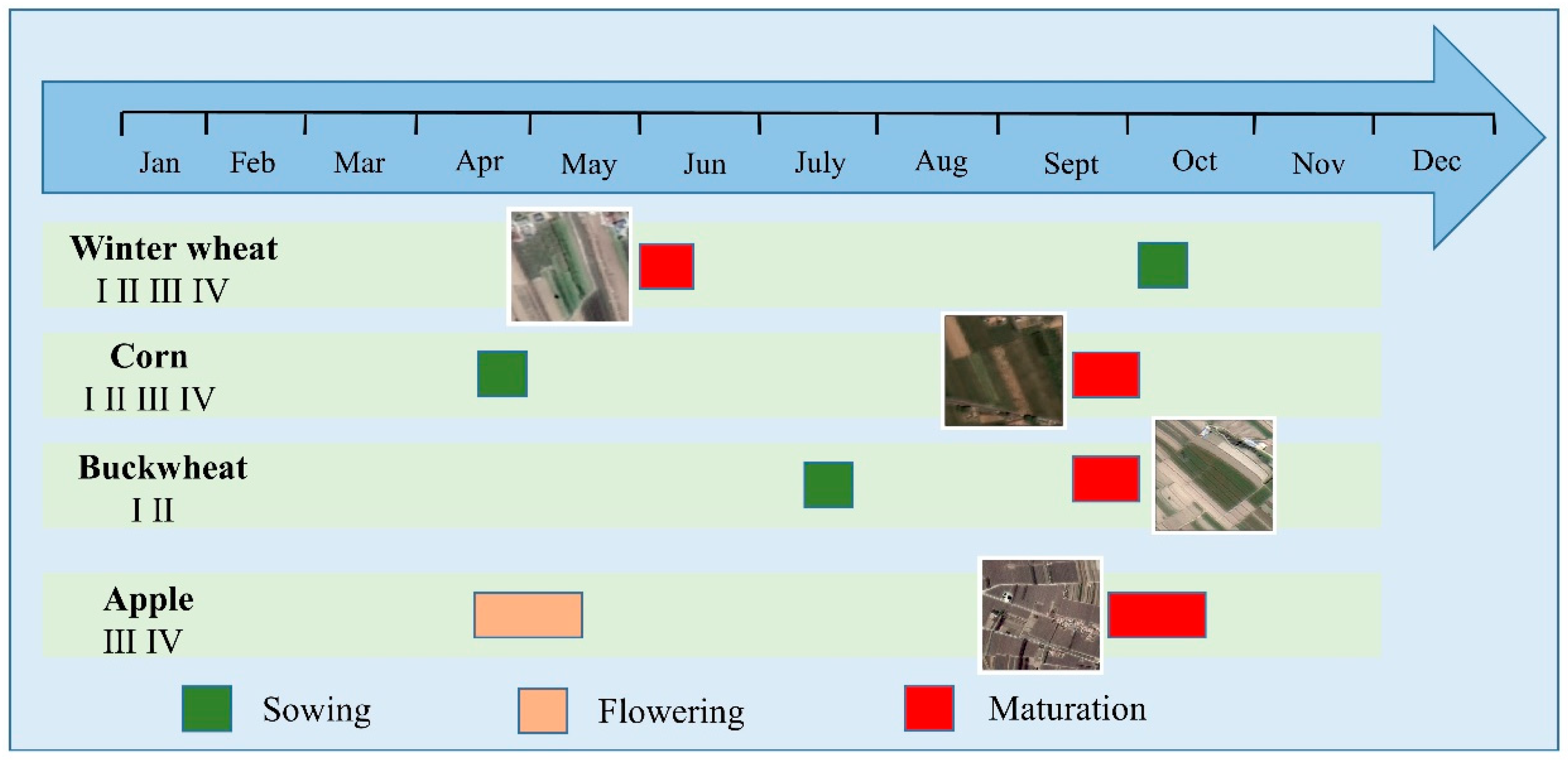
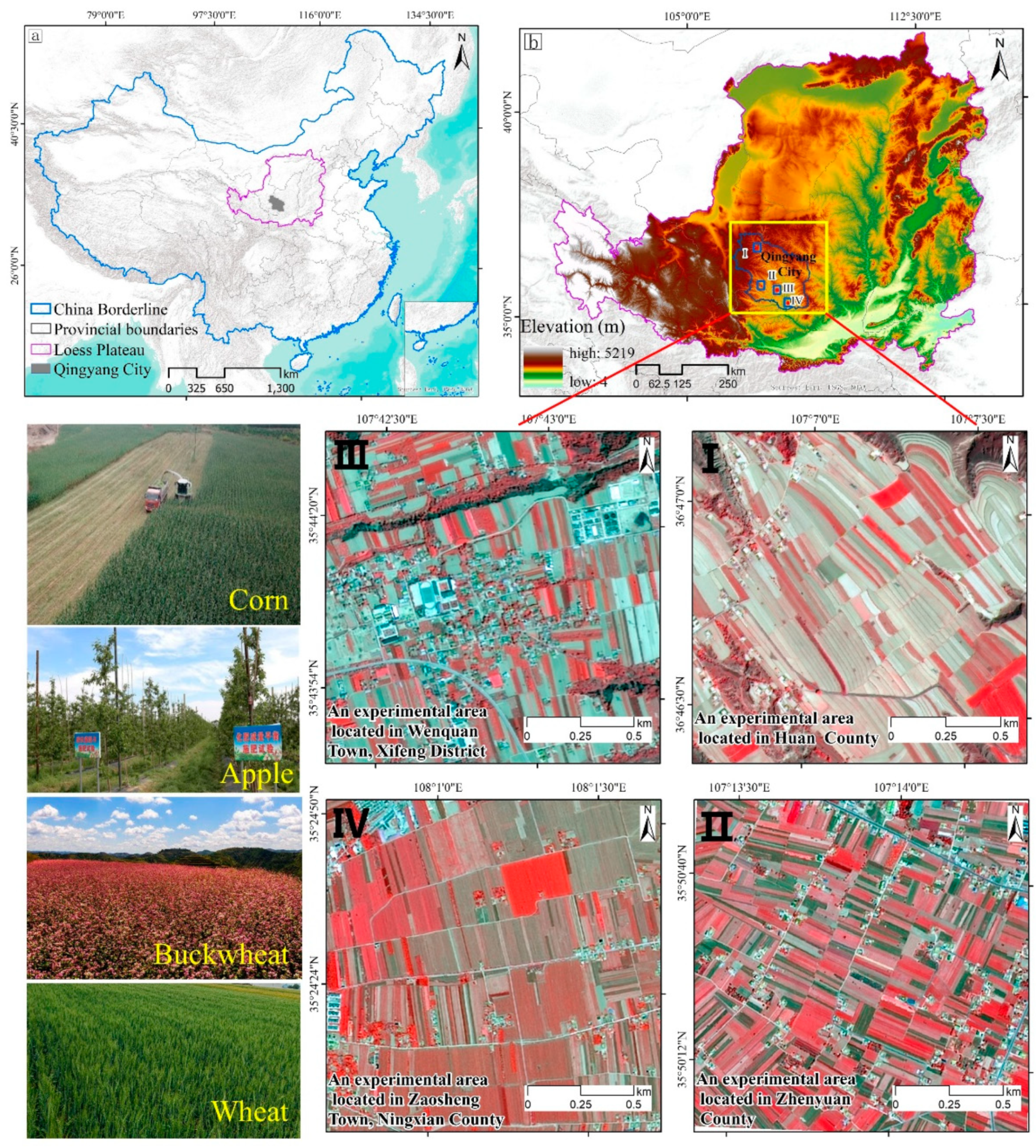
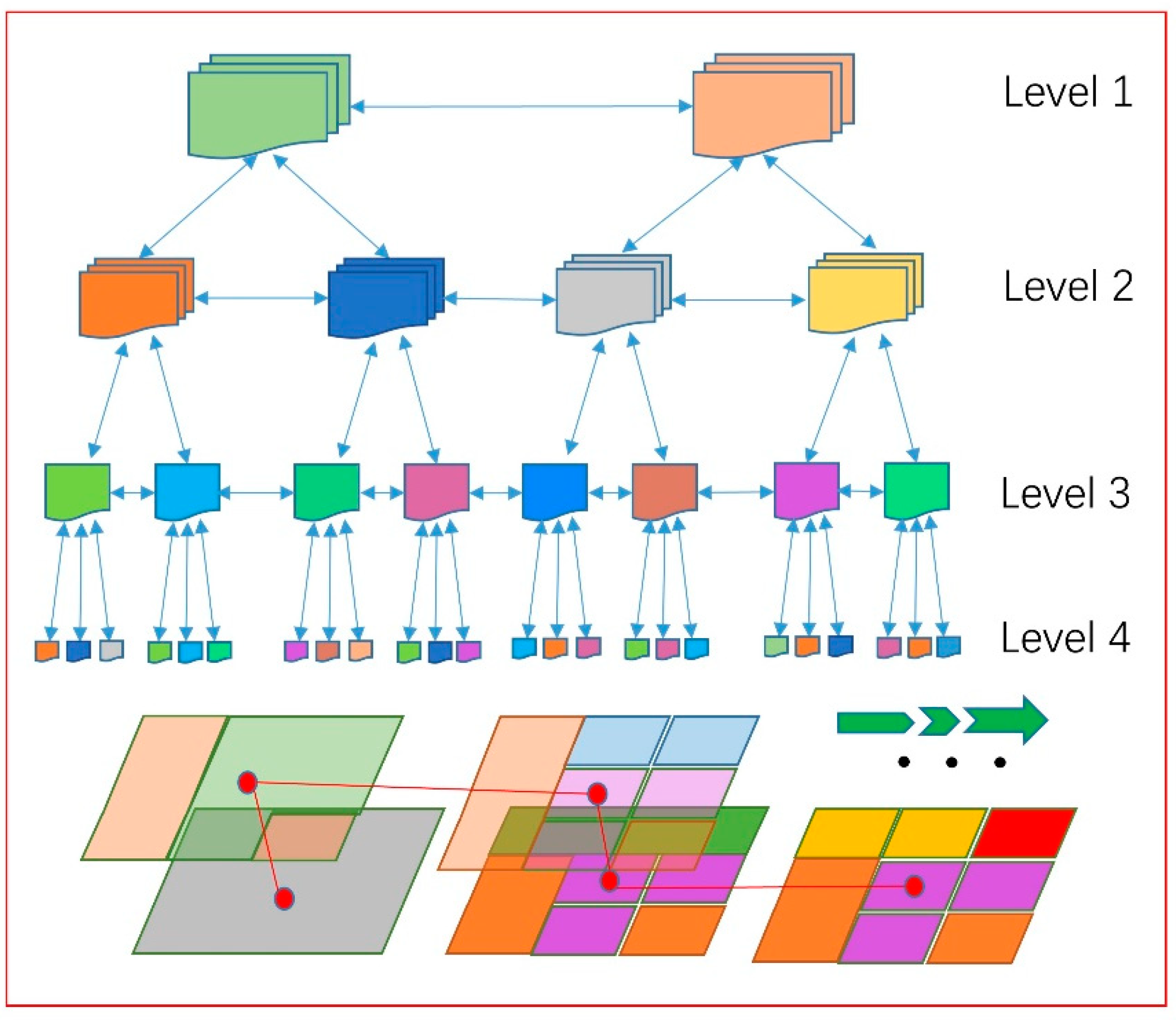
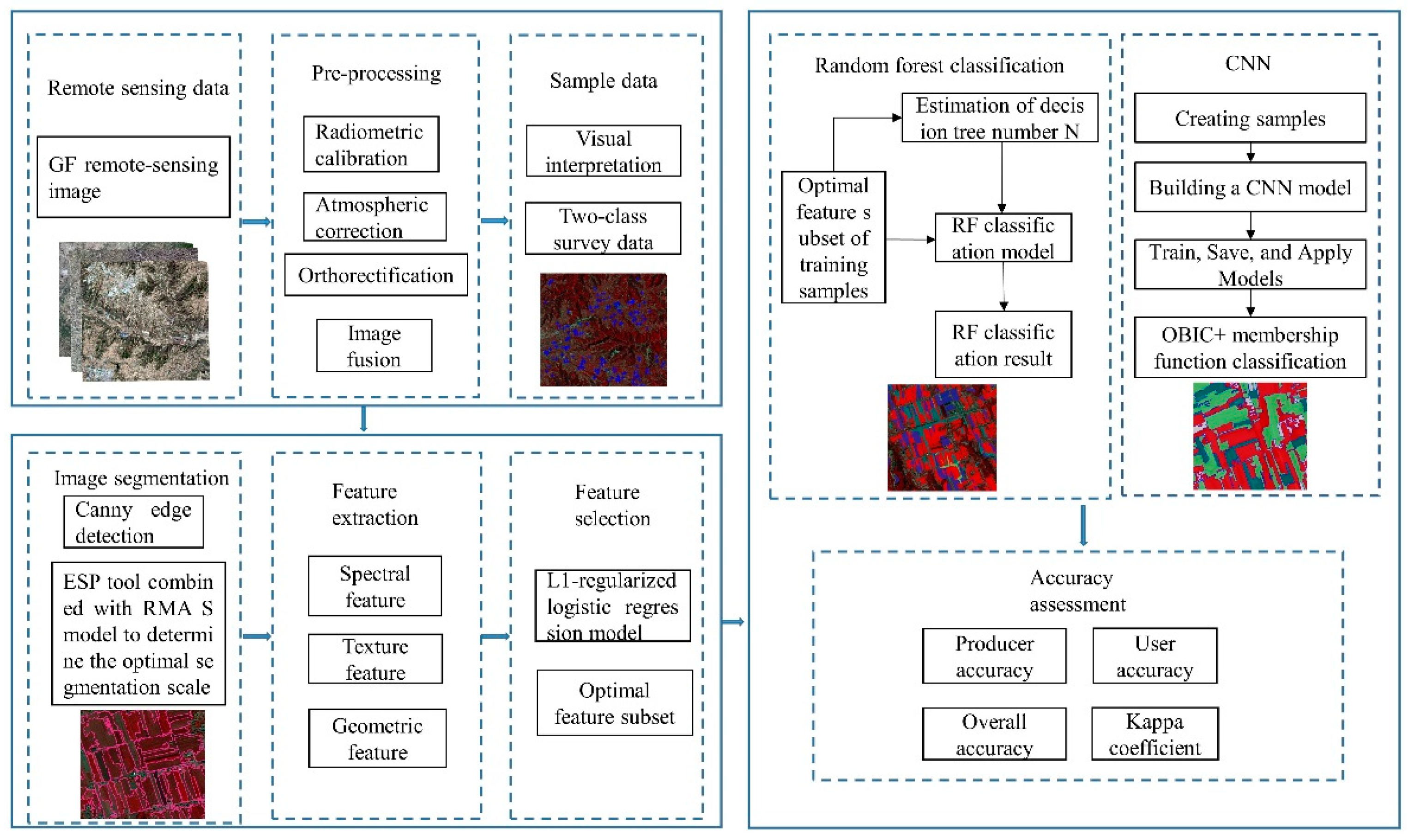
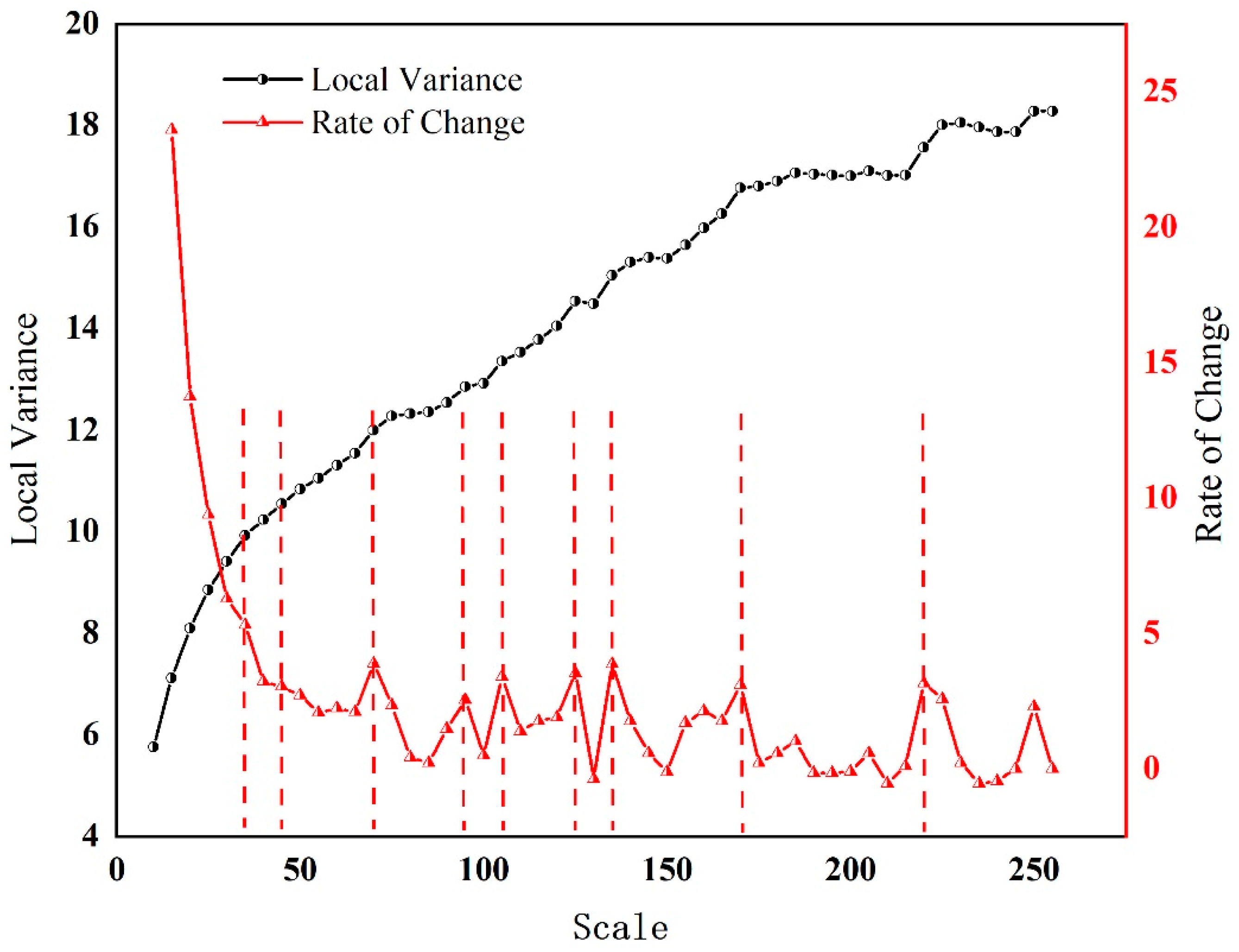
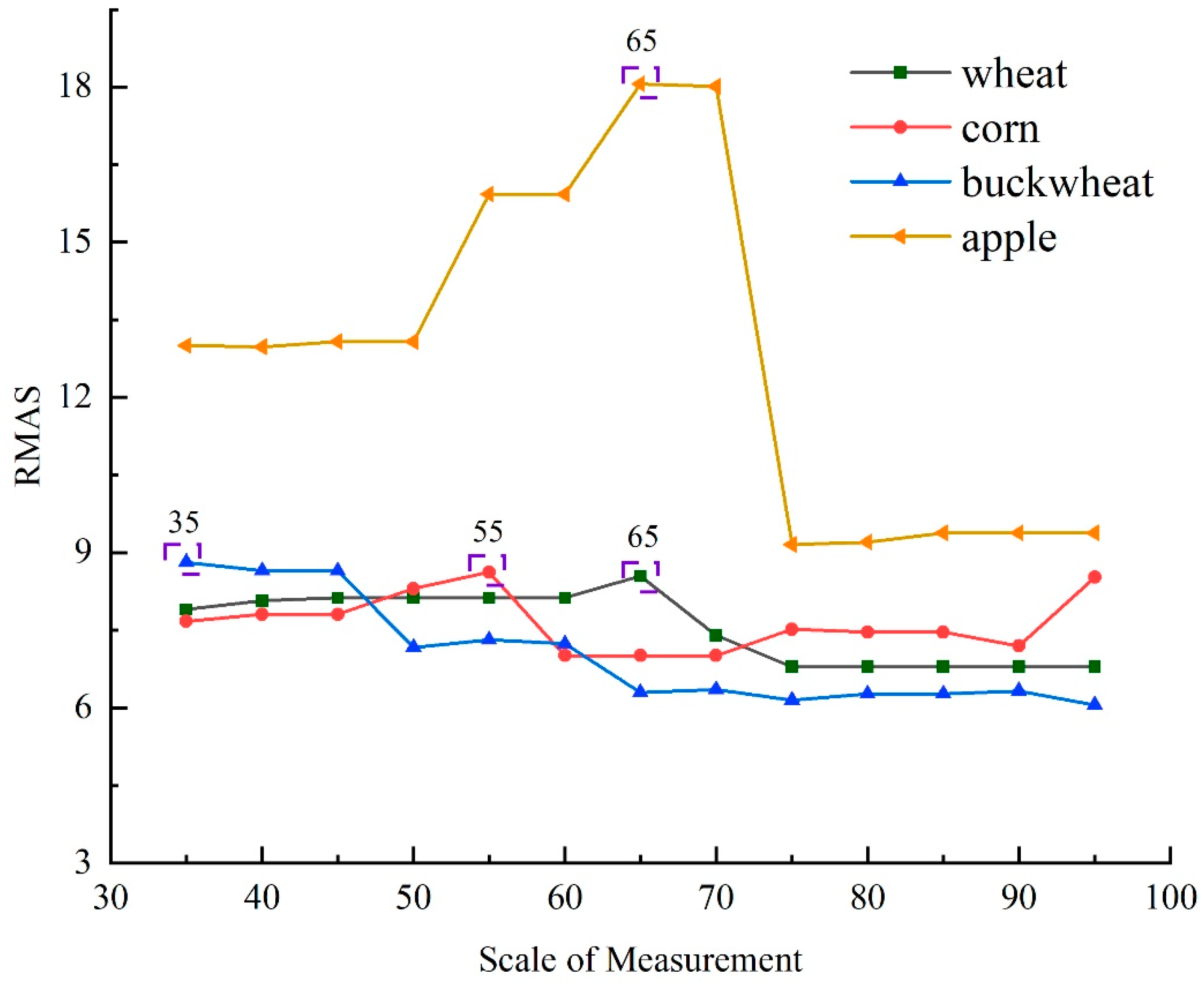
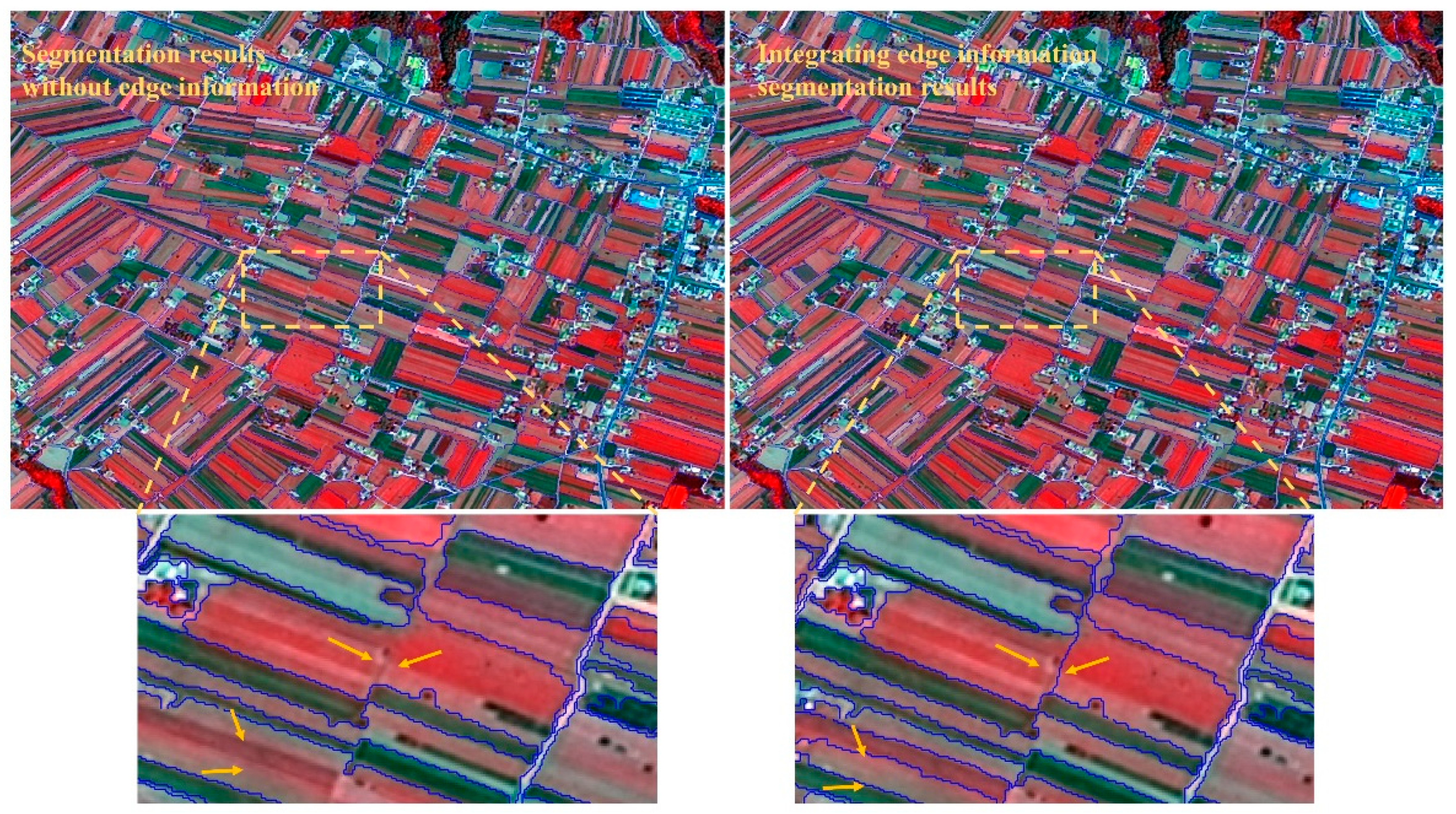
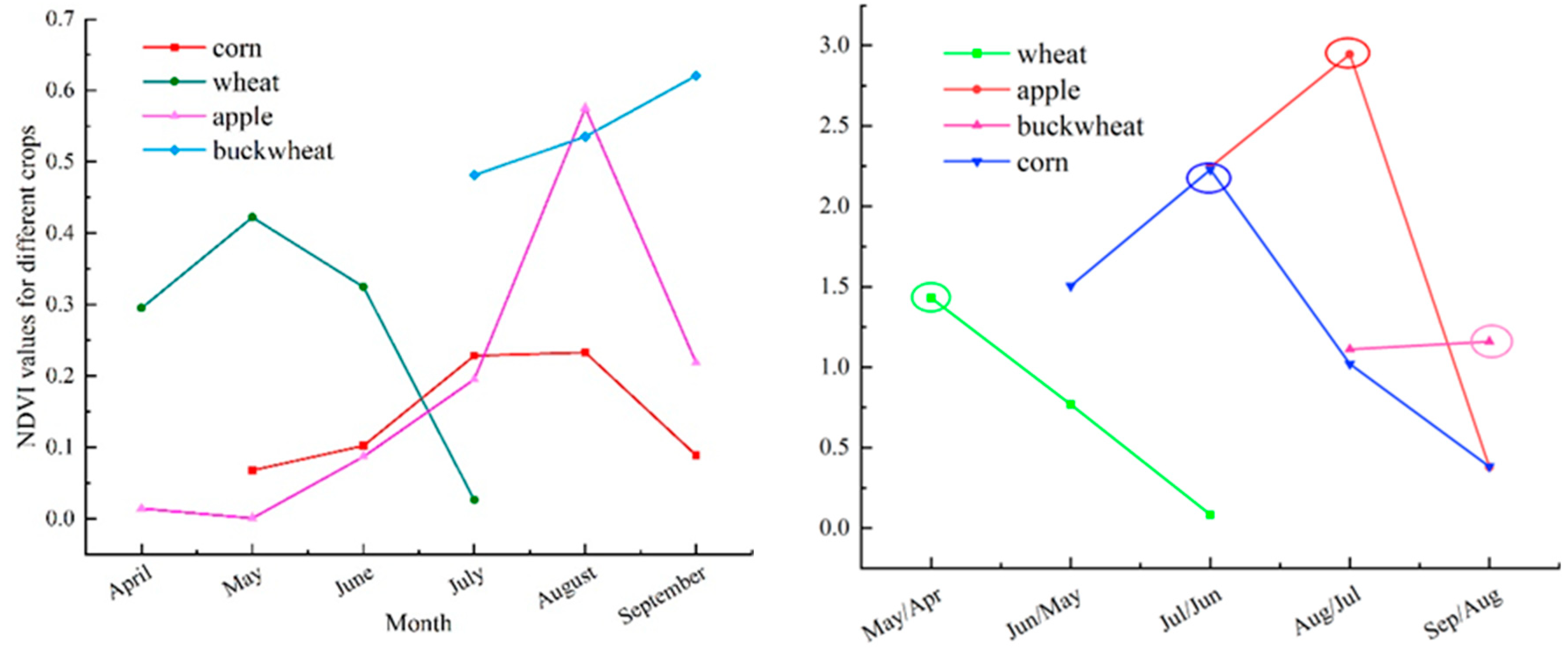
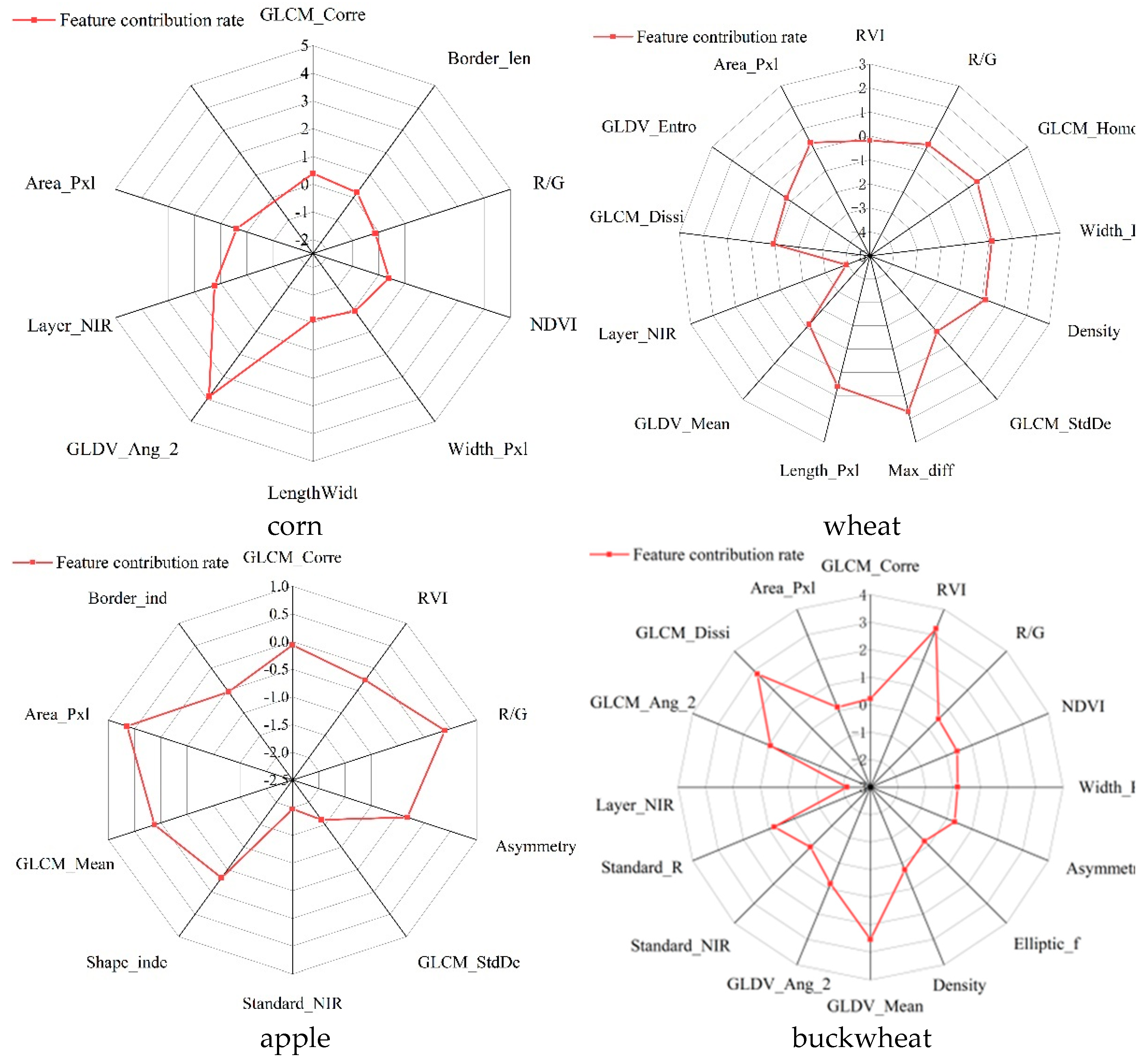
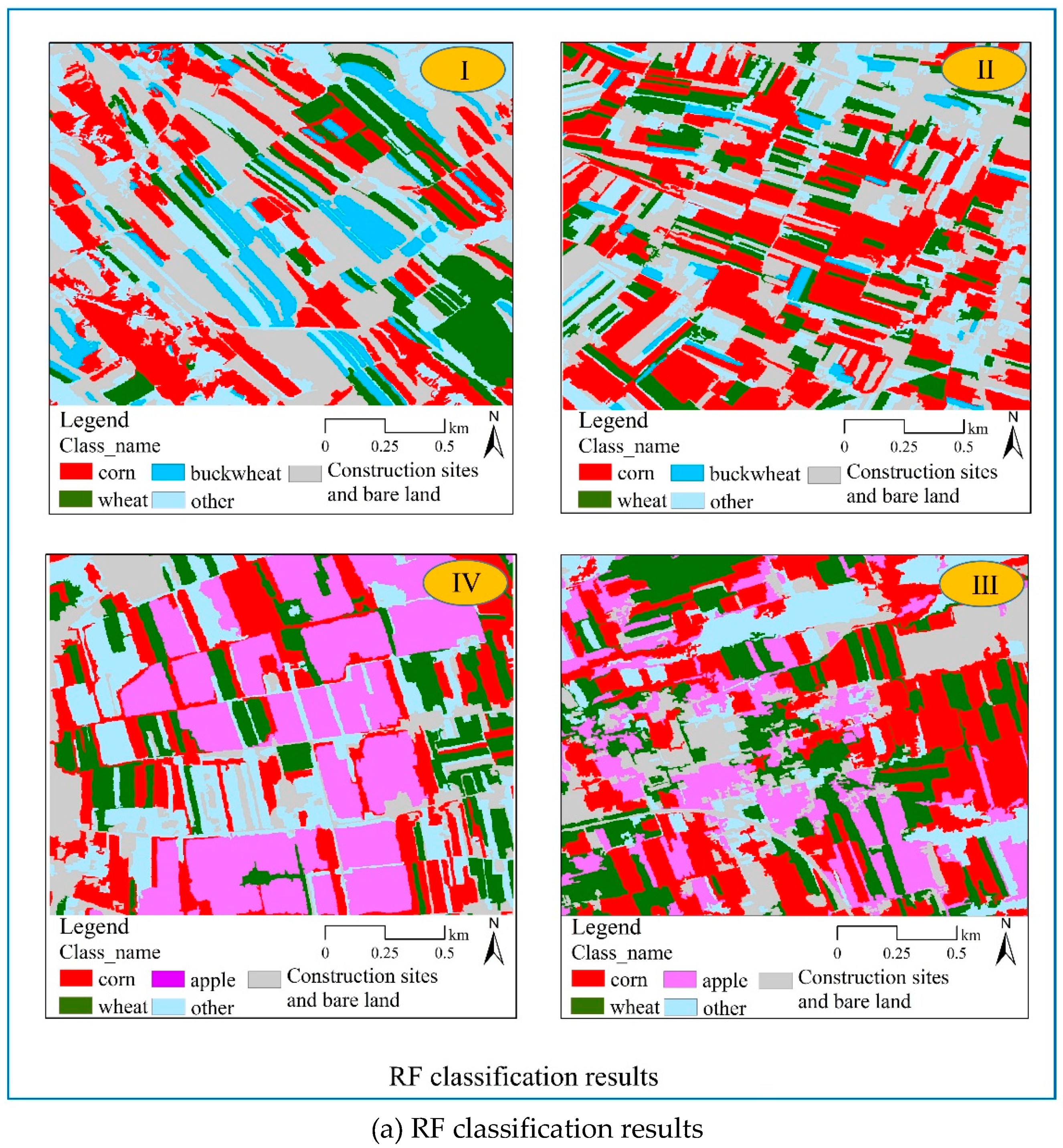
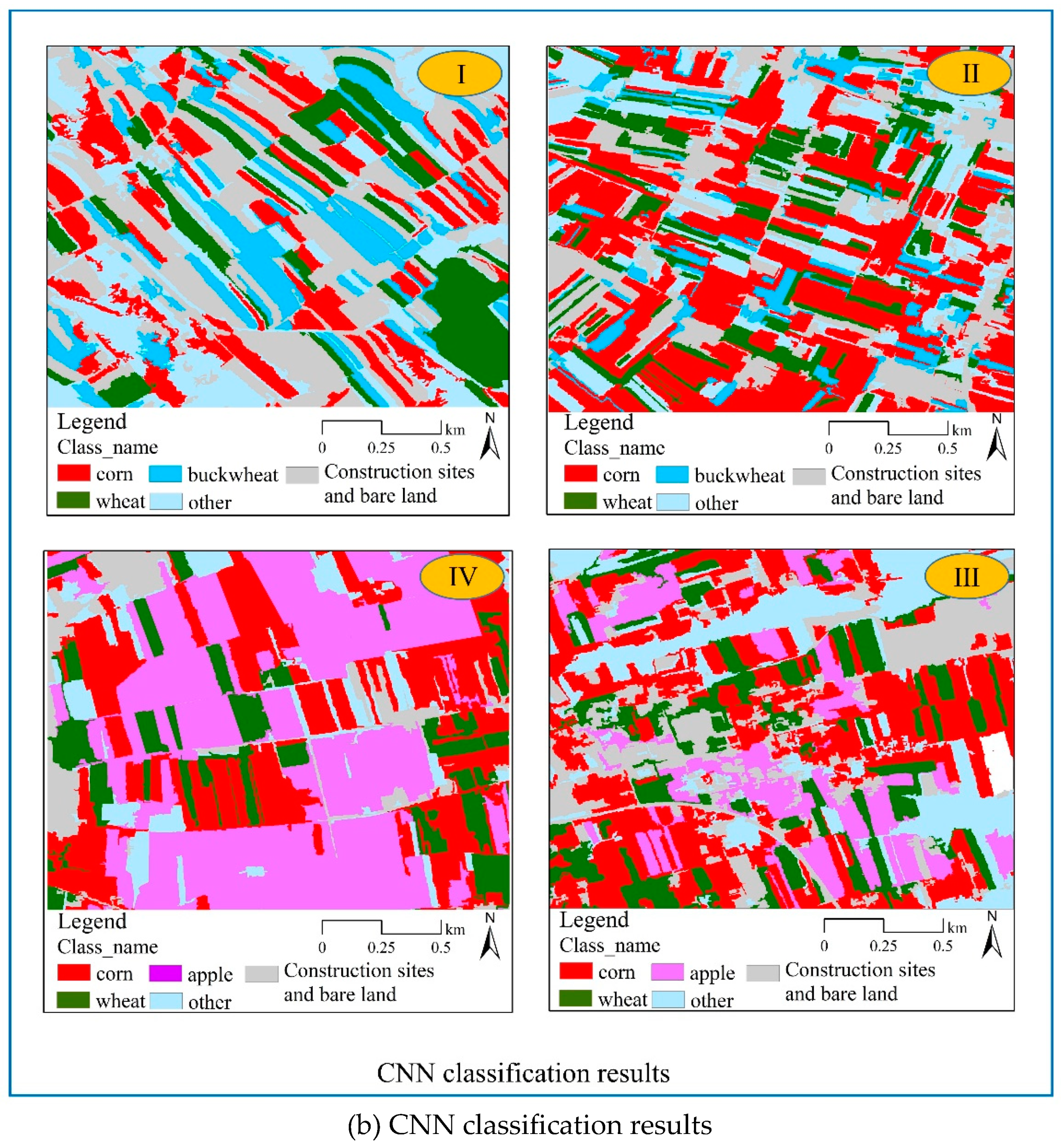
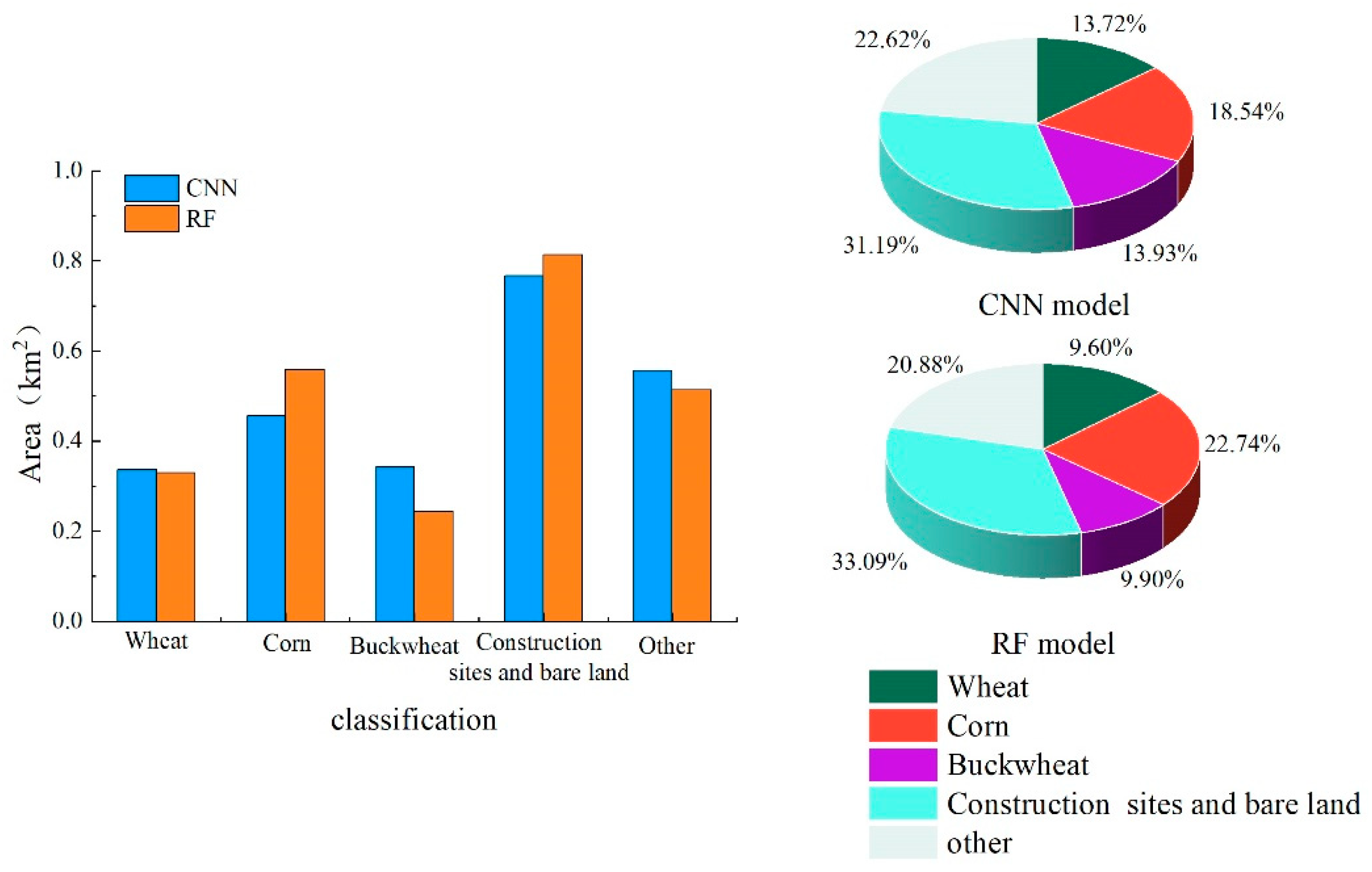
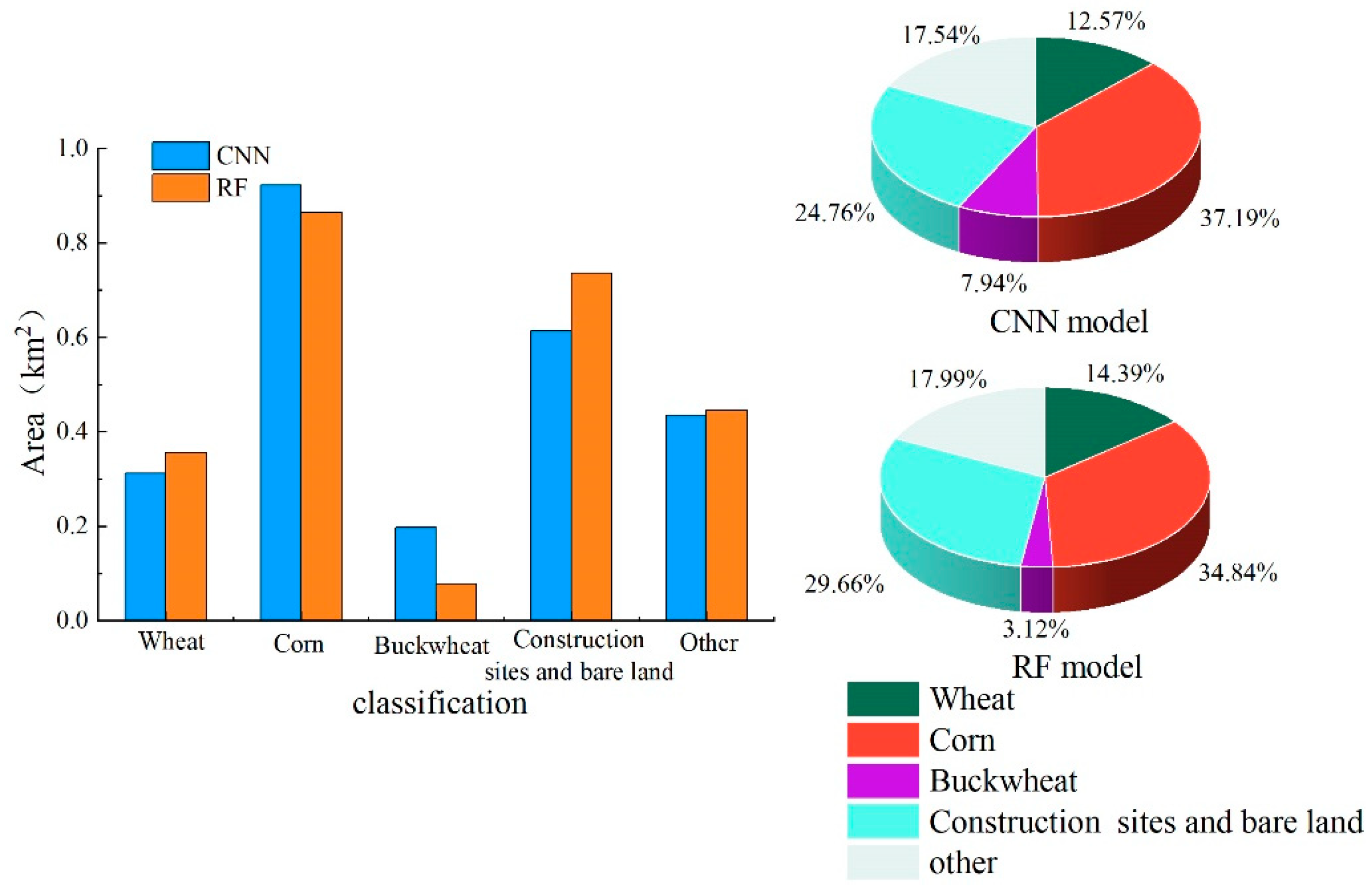
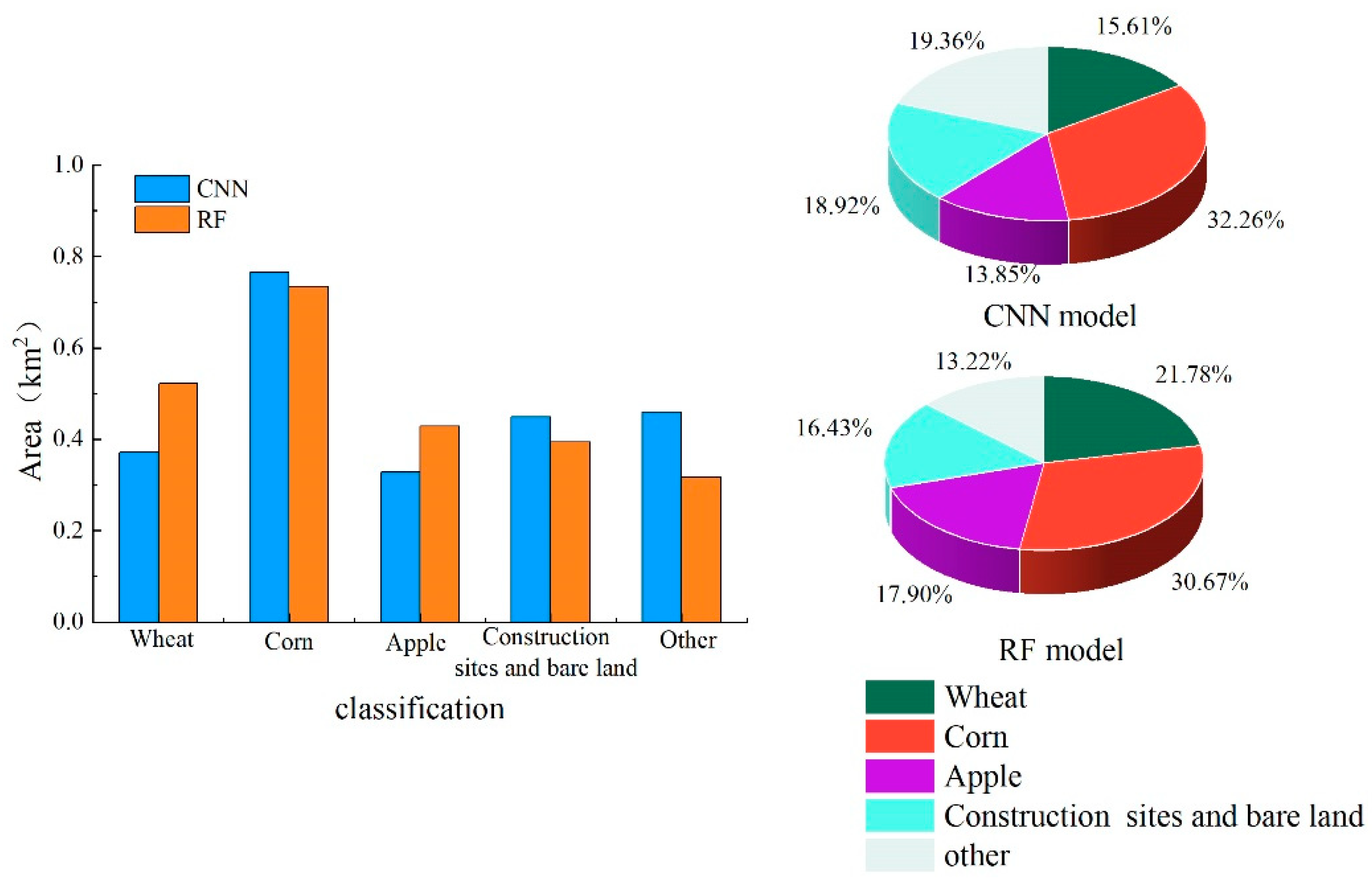
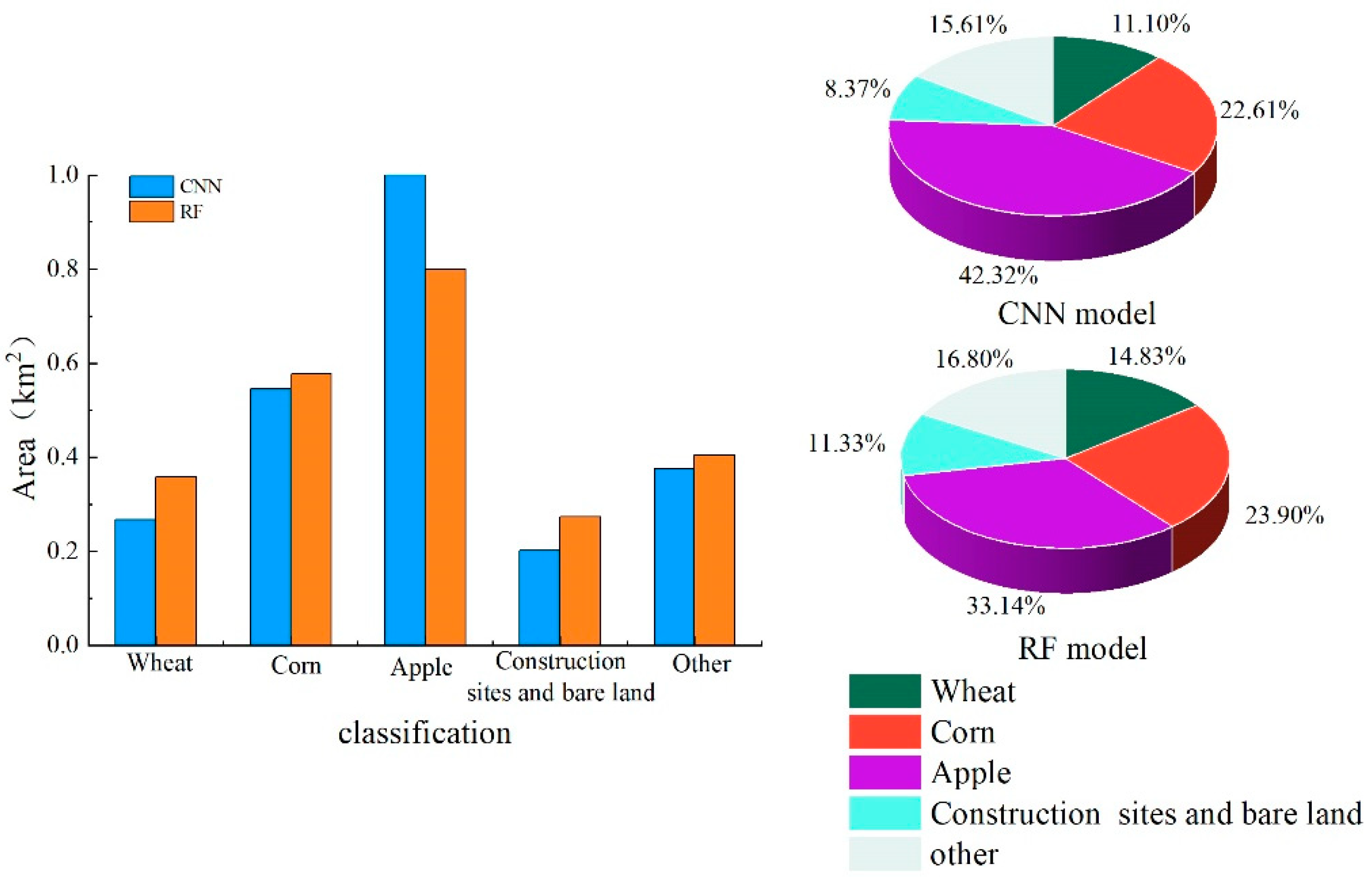
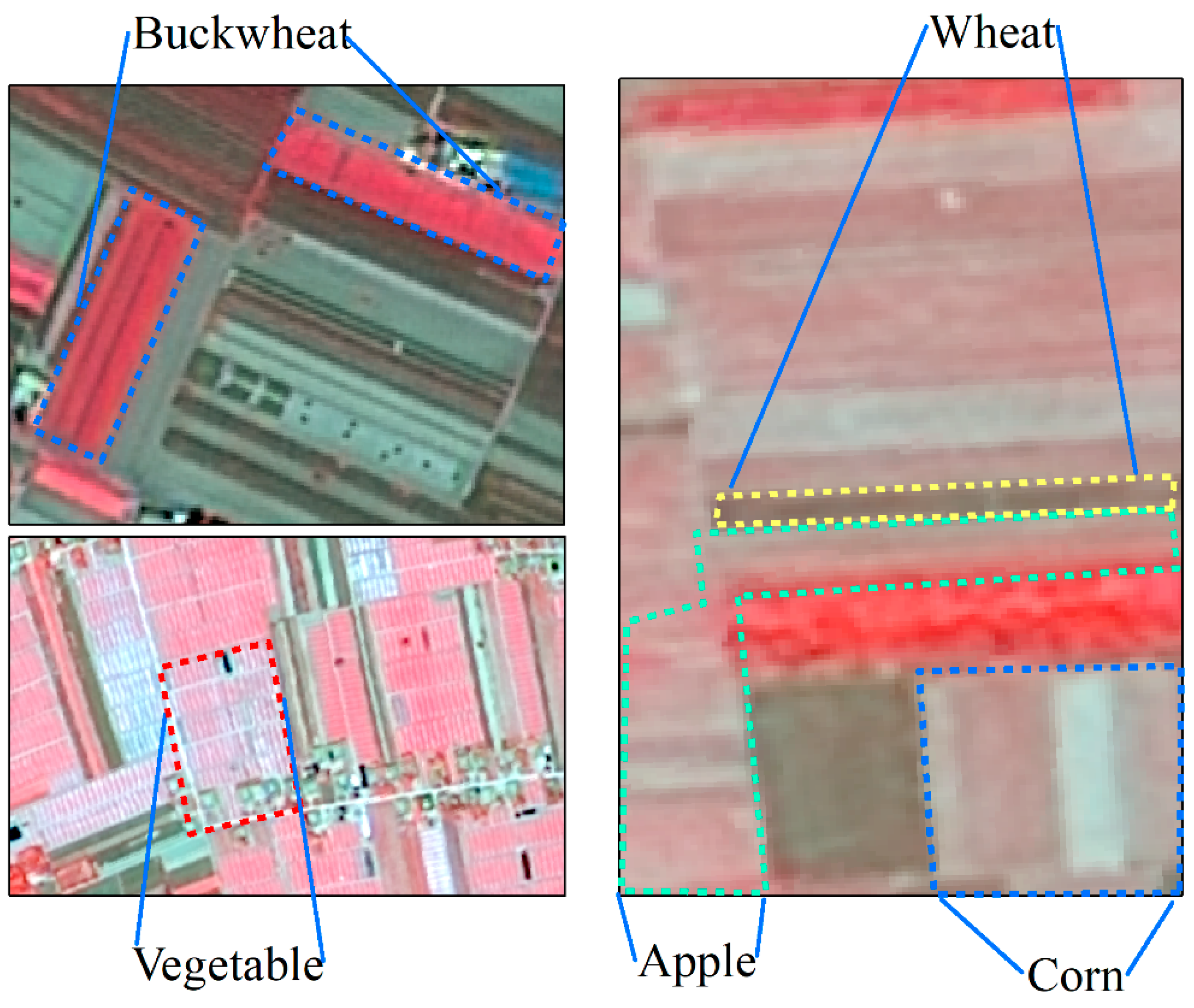
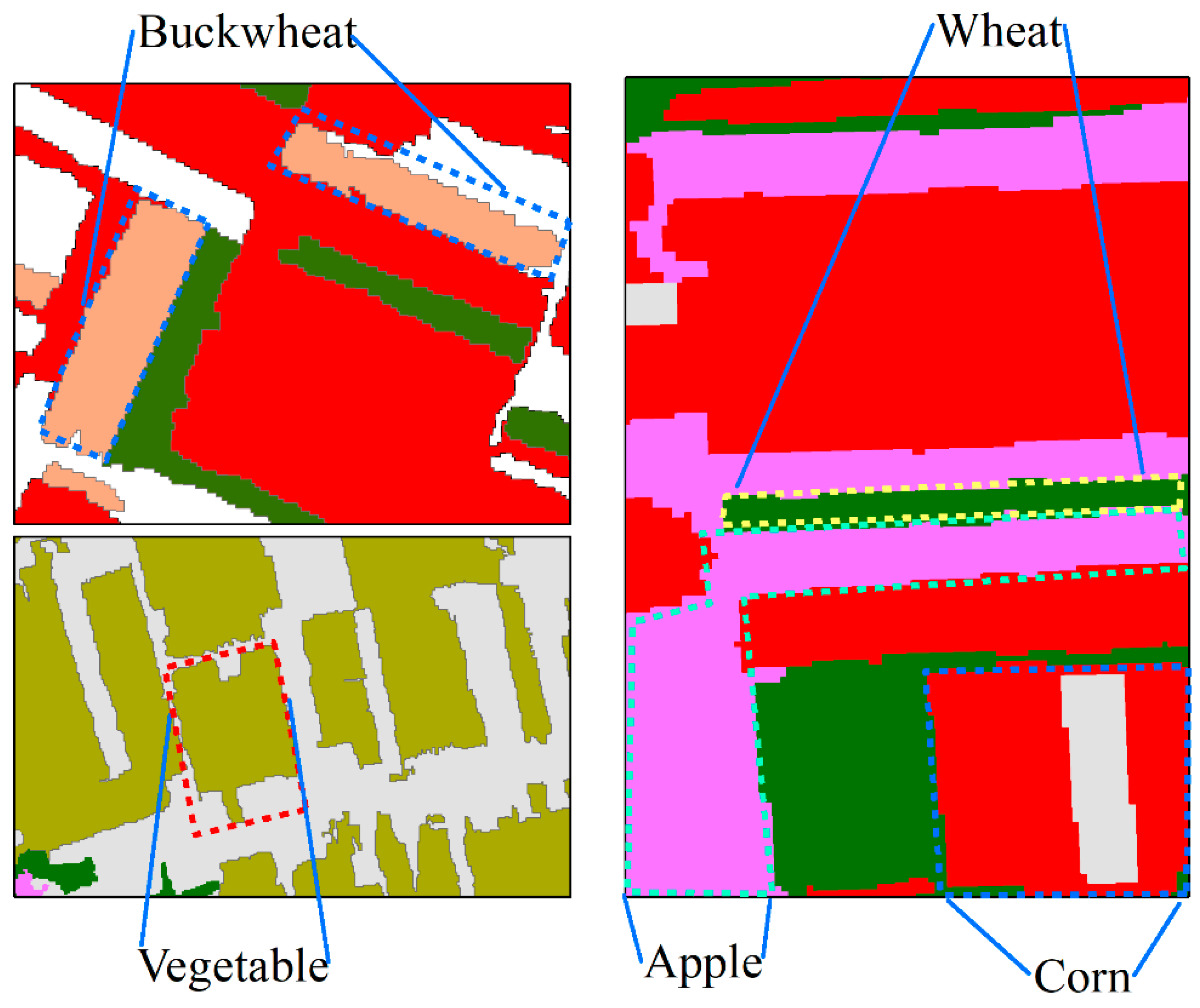
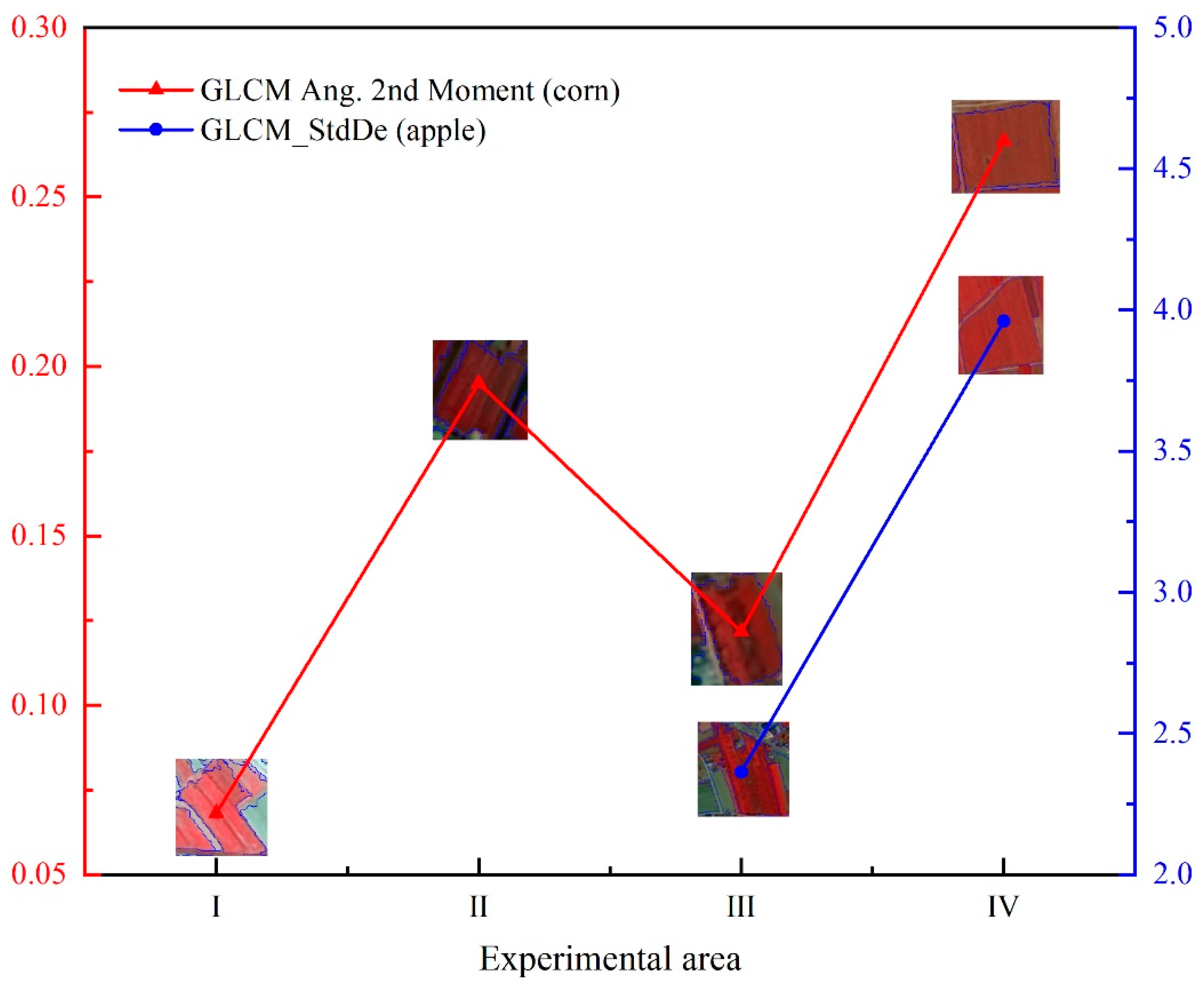
| Name of satellite | Sensor (PMS) | Spatial resolution (m) | Image quantity | |||
|---|---|---|---|---|---|---|
| Ⅰ | Ⅱ | Ⅲ | Ⅳ | |||
| GF-1 | PMS1/PMS2 | 2 | / | 2 | 1 | / |
| GF-2 | PMS1/PMS2 | 1 | 4 | 1 | 1 | 4 |
| GF-6 | PMS1/PMS2 | <2 | / | 1 | 2 | / |
| Feature category | Feature variable | Total/number |
|---|---|---|
| Spectral feature | Mean_R, Mean_G, Mean_B, Mean_NIR, Max_diff、Briahtness and Standard Deviation (four bands) | 10 |
| Texture features | GLCM Mean, GLCM Ent, GLCM Homo, GLCM Std, GLCM Dissim, GLCM Contrast and GLCM Ang. 2nd Moment, GLCM Corr, GLDV Mean, GLDV Ent, GLDV Contrast and GLDV Ang. 2nd Moment | 12 |
| Geometric features | Area, length/Width, length, Width, Border Length, Shape lndex, Density, Asymmetry, Roundness, Boundary Index, Compactness, Ellipse Fitting, Rectangle Fitting | 13 |
| Index features | EVI, NDVI, R/G and RVI | 4 |
| Test area | Type of Crops | Kappa coefficient of each crop | Kappa coefficient of overall classification results | Overall Accuracy | |||
|---|---|---|---|---|---|---|---|
| RF Model |
CNN Model |
RF Model |
CNN Model |
RF Model |
CNN Model |
||
| Ⅰ | Wheat | 0.92 | 0.90 | 0.89 | 0.87 | 0.92 | 0.91 |
| Corn | 0.85 | 0.81 | |||||
| Buckwheat | 0.96 | 0.93 | |||||
| Ⅱ | Wheat | 0.93 | 0.89 | 0.91 | 0.88 | 0.95 | 0.93 |
| Corn | 0.91 | 0.87 | |||||
| Buckwheat | 0.86 | 0.88 | |||||
| Ⅲ | Wheat | 0.87 | 0.89 | 0.85 | 0.84 | 0.89 | 0.89 |
| Corn | 0.84 | 0.81 | |||||
| Apple | 0.85 | 0.80 | |||||
| Ⅳ | Wheat | 0.86 | 0.79 | 0.86 | 0.85 | 0.91 | 0.90 |
| Corn | 0.78 | 0.86 | |||||
| Apple | 0.93 | 0.89 | |||||
Disclaimer/Publisher’s Note: The statements, opinions and data contained in all publications are solely those of the individual author(s) and contributor(s) and not of MDPI and/or the editor(s). MDPI and/or the editor(s) disclaim responsibility for any injury to people or property resulting from any ideas, methods, instructions or products referred to in the content. |
© 2024 by the authors. Licensee MDPI, Basel, Switzerland. This article is an open access article distributed under the terms and conditions of the Creative Commons Attribution (CC BY) license (http://creativecommons.org/licenses/by/4.0/).





